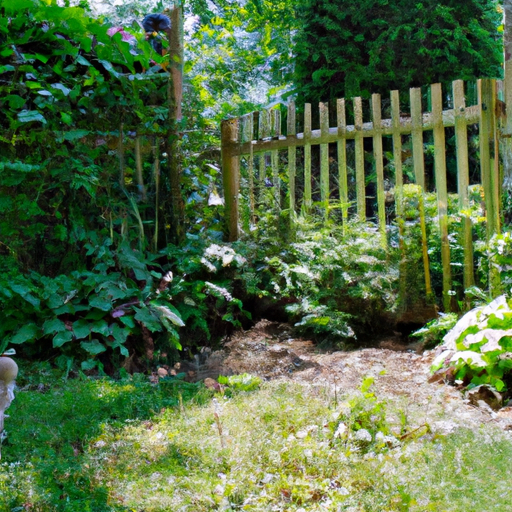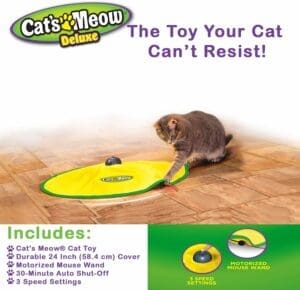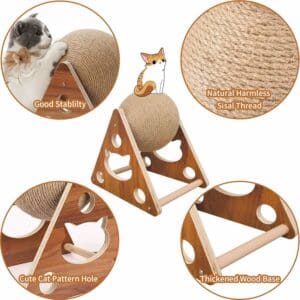If you’re a proud cat owner who wants to give your furry friend the opportunity to explore the great outdoors, it’s important to ensure their safety while they roam outside. Cat-proofing your garden is a crucial step in keeping your kitty safe and secure in their outdoor adventures. In this article, you’ll discover helpful tips and strategies to create a cat-friendly garden that will minimize potential hazards and provide an enriching environment for your beloved feline companion. So, let’s get started on making your garden a serene sanctuary for your kitty to enjoy!
Creating a Safe Environment
Identifying potential hazards
When it comes to creating a safe environment for your furry friend, the first step is to identify any potential hazards in your garden. Look for any sharp objects, toxic substances, or other dangerous items that your cat may come into contact with. It’s important to remove or secure these hazards to prevent any accidents or injuries.
Securing fences and boundaries
A crucial aspect of cat-proofing your garden is ensuring that your fences and boundaries are secure. Cats are natural explorers and can easily find their way out if there are any gaps or weak spots in the fencing. Regularly inspect your fences and repair any damaged areas to prevent your cat from escaping or other animals from entering your garden.
Using cat-friendly plants
To create a safe and enjoyable outdoor space for your cat, consider incorporating cat-friendly plants into your garden. These plants provide a stimulating environment for your feline friend and can help keep them away from any potentially harmful plants. Some great options include catnip, cat thyme, and valerian.
Creating a designated play area
It’s important to provide your cat with a designated play area in your garden. This area should be secure and free from any hazards. Consider adding toys, scratching posts, and other cat-friendly features to encourage play and exercise. Having a designated play area will not only keep your cat entertained but also help ensure their safety in the outdoor space.
Eliminating Toxic Plants
Researching toxic plants
Before creating a cat-friendly garden, it’s crucial to research and identify any toxic plants that may be present. Some common plants, such as lilies, azaleas, and certain types of ferns, can be toxic to cats if ingested. Make a list of these plants and ensure they are removed or kept out of your cat’s reach.
Removing dangerous flora from the garden
Once you have identified the toxic plants in your garden, take the necessary steps to remove them. Dig out the plants, including the roots, to prevent any regrowth. If removing the plants is not feasible, consider relocating them to an area where your cat cannot access them.
Providing alternative safe plants
Instead of toxic plants, consider adding alternative safe plants to your garden. Plants such as cat grass, catnip, and lemongrass are not only safe for your cat but also provide additional sensory stimulation and enrichment. These plants can be grown in pots or designated areas to encourage your cat’s interaction with them.
Using deterrents to keep cats away from toxic plants
Even after removing toxic plants and introducing safe alternatives, it’s important to use deterrents to prevent your cat from approaching or nibbling on any plants that might still pose a risk. There are numerous commercial repellents available that are safe for cats but help deter them from certain areas. Additionally, you can consider using natural deterrents such as citrus peels or cayenne pepper sprinkled around the plants.
Building a Cat-Friendly Fence
Choosing the right fence material
When building a cat-friendly fence, selecting the right material is essential. Opt for materials that are sturdy and difficult for cats to climb, such as smooth wood or metal fencing. Avoid chain-link fences or fences with wide gaps, as cats may be able to squeeze through or climb them.
Adding overhangs and netting
To further enhance the security of your cat-friendly fence, consider adding overhangs and netting. Overhangs make it more challenging for cats to climb over the fence, while netting prevents them from squeezing through any small gaps. These additions provide an extra layer of protection and discourage escape attempts.
Using motion-activated sprinklers
Another effective way to deter cats from approaching the fence is by installing motion-activated sprinklers. These sprinklers detect the presence of a cat and deliver a harmless burst of water, scaring them away from the fence. This not only helps keep your cat safe but also prevents them from encountering potential dangers beyond the boundary of your garden.
Installing cat-proof gates or barriers
In addition to securing the perimeter of your garden with a cat-friendly fence, it’s important to install cat-proof gates or barriers at entry points to prevent your cat from escaping or other animals from entering. These gates should be tall enough to discourage jumping and have small gaps to prevent cats from squeezing through.
Cat-Proofing Garden Features
Securing ponds and water features
If your garden has a pond or other water features, it’s essential to secure them to ensure your cat’s safety. Cats are naturally curious and may be attracted to bodies of water. Install a sturdy mesh or netting over the pond to prevent your cat from falling in or getting trapped.
Covering holes or gaps in structures
Inspect any structures in your garden, such as sheds or garden sheds, for any holes or gaps that your cat may be able to squeeze through. Cover these openings with mesh or other materials to prevent your cat from getting stuck or escaping.
Protecting garden furniture and structures from scratching
Cats love to scratch, and your garden furniture and structures may become their targets. To protect your outdoor belongings from your cat’s claws, consider using cat-safe deterrents such as sticky tape or aluminum foil on surfaces that you want to keep scratch-free. Providing designated scratching posts nearby can also help redirect your cat’s scratching behavior.
Removing potential hiding spots
As natural hunters, cats love to explore and hide in various nooks and crannies. However, some hiding spots in your garden may pose a danger to them. Remove any potential hiding spots that could trap or harm your cat, such as gaps between walls or under heavy objects.
Creating Vertical Spaces
Providing tall scratching posts or trees
Cats love to climb and scratch, so providing them with tall scratching posts or trees can fulfill their natural instincts. These vertical spaces not only offer your cat a vantage point to survey their surroundings but also provide them with opportunities for exercise and mental stimulation. Make sure the scratching posts or trees are secure and stable to prevent accidents.
Installing cat shelves or climbers
Cat shelves or climbers are another great way to create vertical spaces in your garden. These shelves can be attached to walls, fences, or trees to provide additional climbing and resting areas for your cat. Make sure the shelves are sturdy and at varying heights to cater to your cat’s preferences.
Using cat-friendly wall or fence attachments
To maximize vertical space in your garden, consider using cat-friendly wall or fence attachments. These can include shelves, tunnels, or hammocks designed specifically for cats. These attachments not only offer your cat an elevated space but also add visual interest to your garden.
Adding cat-safe outdoor enclosures
If you have the space and resources, consider adding a cat-safe outdoor enclosure to your garden. These enclosures provide a fully enclosed space for your cat to explore and enjoy the outdoors safely. They can be attached to your house or freestanding structures and can range in size and complexity.
Implementing Safe Boundaries
Installing invisible or electric fences
For those who want to provide their cats with access to a larger outdoor space, invisible or electric fences can be a viable option. These systems create an invisible boundary using an underground wire or wireless technology. When your cat approaches the boundary, a mild static correction is triggered, alerting them to retreat.
Using boundary training techniques
Even with the use of invisible or electric fences, it’s important to train your cat to recognize and respect the boundaries. Spend time gradually introducing your cat to the boundaries and rewarding them when they stay within the safe zone. Positive reinforcement and consistency are key to successful boundary training.
Utilizing cat-friendly deterrents
To further reinforce the safe boundaries of your garden, consider using cat-friendly deterrents such as scented sprays or ultrasonic devices that emit high-frequency sounds. These deterrents help discourage your cat from venturing beyond the designated area and reinforce the desired behavior of staying within the boundaries.
Providing supervised outdoor time
No matter how secure your garden may be, it’s important to supervise your cat when they are outdoors. This allows you to monitor their behavior, ensure their safety, and intervene if necessary. Avoid leaving your cat unattended for extended periods, especially if they are not yet familiar with the boundaries of your garden.
Avoiding Chemical Contaminants
Using organic or pet-friendly fertilizers
When maintaining your garden, opt for organic or pet-friendly fertilizers. Traditional fertilizers may contain harmful chemicals that can be toxic to cats if ingested or in contact with their skin. By using organic alternatives, you can keep your garden healthy while ensuring the safety of your furry friend.
Avoiding pesticides and herbicides
Similarly, avoid using pesticides and herbicides in your garden, as these chemicals can pose a risk to your cat’s health. Instead, explore natural methods of pest control, such as planting companion plants or introducing beneficial insects. Regularly inspect your plants to identify any signs of pests or diseases and take appropriate action.
Safe storage of gardening chemicals
If you do use gardening chemicals, make sure to store them safely and securely. Keep them in a locked cabinet or in a separate, cat-free storage area to prevent accidental ingestion or exposure. Ensure all containers are tightly sealed and properly labeled to avoid any potential dangers.
Creating a separate, cat-free storage area
To minimize the risk of your cat coming into contact with potentially harmful gardening chemicals, consider creating a separate storage area that is off-limits to your furry friend. Store all gardening supplies, tools, and chemicals in this designated area to prevent any accidents or exposure.
Preventing Wildlife Hazards
Installing bird feeders to distract cats
Cats are natural hunters, and birds may be a tempting target in your garden. To distract your cat from chasing birds, consider installing bird feeders in an area away from where your cat spends most of their time. This can help redirect their attention and prevent them from engaging in harmful hunting behaviors.
Using noise or motion-activated devices
To deter wildlife from entering your garden and potentially causing harm to your cat, consider using noise or motion-activated devices. These devices emit sounds or create movements that startle animals and discourage them from approaching. Remember to choose devices that are safe for both wildlife and your cat.
Ensuring wildlife-friendly garden practices
Promoting a wildlife-friendly garden can help reduce the risk of potentially harmful encounters between animals and your cat. Avoid using netting or traps that may inadvertently harm wildlife. Additionally, provide food, water, and shelter for local wildlife in designated areas to encourage them to frequent different parts of your garden.
Regularly checking for wildlife presence
Regularly check your garden for signs of wildlife presence, such as footprints or droppings, to ensure you are aware of any potential hazards. This will allow you to take necessary precautions and adapt your garden maintenance practices accordingly.
Monitoring and Supervision
Keeping an eye on your cat’s behavior
It’s essential to keep a close eye on your cat’s behavior when they are in the garden. Monitor their interactions with plants, fences, boundaries, and wildlife. If you notice any unusual behavior, signs of distress, or changes in their health, consult with your veterinarian as they may be indicators of potential issues.
Supervising outdoor playtime
Whenever your cat is enjoying some outdoor playtime, it’s important to provide supervision. Although you may have cat-proofed your garden to the best of your ability, unexpected incidents can still occur. Being present allows you to intervene if necessary and ensure your cat’s safety.
Using cameras or tracking devices
To enhance the supervision of your cat in the garden, consider using cameras or tracking devices. These can provide additional peace of mind by allowing you to monitor your cat’s activities remotely or track their location in real-time. Choose devices that are suitable for outdoor use and compatible with your needs.
Noticing signs of distress or illness
While your cat is enjoying their outdoor time, pay close attention to any signs of distress or illness. Cats are notorious for hiding signs of illness, so it’s important to be vigilant. If you notice any changes in behavior, appetite, or litter box habits, consult with your veterinarian promptly.
Educating Neighbors and Visitors
Informing neighbors about your cat’s presence
To minimize the risk of your cat encountering any dangers from neighbors or their pets, take the time to inform them about your cat’s presence. Let them know that your cat is allowed outdoor access and request that they exercise caution when using potentially harmful substances or allowing their pets to roam freely.
Requesting caution around the garden
When welcoming visitors to your home, specifically request that they exercise caution around your garden. Remind them that your cat’s safety is a priority and ask them to be mindful of any open gates or potential hazards. By raising awareness, you can help ensure that your cat remains safe even when you have guests.
Providing alternative play areas for visiting children
If children frequently visit your home, consider providing alternative play areas for them that are separate from your cat’s designated play area. This helps prevent any accidental interactions that may cause stress or harm to either party. Set clear boundaries and provide appropriate supervision to ensure a safe and enjoyable experience for everyone.
Placing warning signs or reminders
To further reinforce the importance of keeping your garden safe for your cat, consider placing warning signs or reminders around the perimeter. These can serve as a visual cue for both residents and visitors to be mindful of their actions and help maintain a secure and cat-friendly environment.








